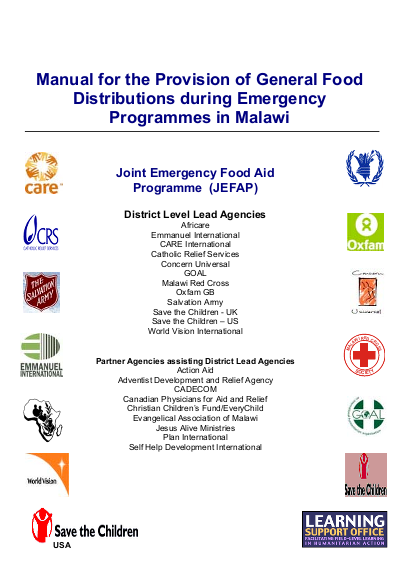
This Manual provides guidance for those involved in the current Joint Emergency Food Aid Programme (JEFAP) general food distribution programme in Malawi. It covers all aspects of the programme and the whole 'distribution cycle', providing guidance on for instance: conducting the first sensitization meetings at the village level; managing the food distribution sites; and completing a Post-Distribution Monitoring Form.
The Manual is intended primarily for use by Field Officers of the agencies that together comprise the JEFAP Consortium. It has been deliberately written in a practical style, providing step-by-step guidance to help Field Officers in ensuring the effective operation of the general food distribution programme. By bringing together in one document information on JEFAP, its policies and procedures and the 'rules' to be followed by agencies involved in the general food distribution programme, the Manual will also be of interest to a much wider audience including District Assembly members, District Executive Committee members, other district officials, members of civil society, local and national politicians, Malawian media organisations, and traditional authorities. In support of the JEFAP principles of transparency and accountability it is planned to meet the needs of this wider interest group by producing a summary version of the Manual translated into several local languages.
This Manual supersedes the various initial guidance notes that were developed by the JEFAP Consortium soon after it was formed in June 2002. It was recognised the initial guidance would need to be reviewed after the initial period of implementation and would benefit from being written in a more practical and accessible style. During October 2002 therefore the Consortium member agencies, supported by the Learning Support Office, organised three regional workshops in Blantyre, Karonga and Lilongwe that brought together a total of 70 Field Officers and other staff from the JEFAP agencies. The workshops reviewed initial experience in the areas of Community Sensitisation and Targeting, Food Distribution and Monitoring.
